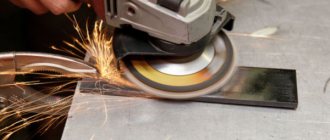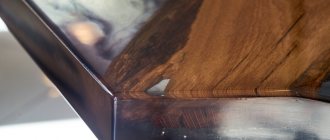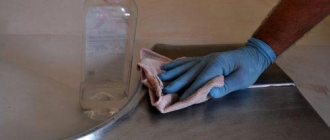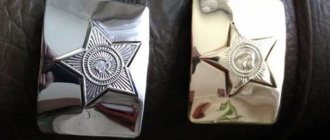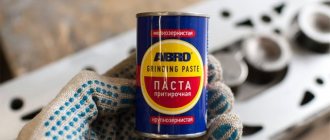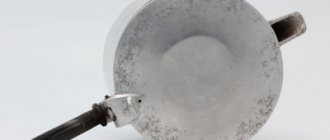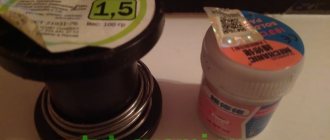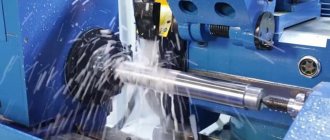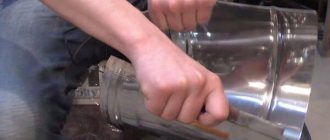Steel parts of machine components of various engines and mechanisms are subjected to several stages of processing. After sanding, the very last step is to apply metal polishing paste. The essence of the polishing process is to remove all the smallest irregularities and scratches from critical surfaces, because with precise adjustment of mechanical elements, all these details, insignificant in the eyes of the average person, can cause a malfunction of the unit and rapid wear of its components.
But polishing is applicable not only inside equipment: the processed visible metal parts look very beautiful. Therefore, product bodies and car bodies are also polished. Metal polish is applied and processed using a certain technology.
Types of polishing pastes for metal
Polishing paste is a multi-component material, which includes a binder and abrasive powder, natural or artificial. Its types can be divided into the following categories:
- According to its intended purpose - for preliminary polishing (rough) and finishing. This property of the paste is determined by the size of the abrasive fraction of which it consists.
- By area of application - polish for steel and other metals, a universal material for treating different types of hard surfaces.
- Easily removed with water, resistant to washing off - the former have a water-soluble structure, the latter are fat-based.
- The consistency is either solid or liquid.
- According to the type of abrasive powder included in the structure of the paste, for example, diamond pastes for polishing metal.
For ease of orientation! The manufacturer usually indicates the number of the mastic, by which you can understand the degree of its roughness, or makes it in different colors (color coding).
Abrasive pastes
It would be more correct to say that all polishing compounds are abrasive, but in popular usage this term refers to metal grinding pastes or coarse mixtures. Their main properties:
- the ability to remove deep marks and roughness from the metal surface;
- high degree of aggressiveness - they quickly eat up a layer of material;
- after grinding with an abrasive material, the treated surface is smooth to the touch, with a characteristic matte tint.
Among diamond polishing materials, coarse ones are those that have a grain size within 40 microns. CBN coarse-grained pastes for processing metal to a rough state can contain grain with a fraction from 125×100 to 40×28 microns.
It would be correct to classify materials of average coarseness as grinding mastics. They allow you to pre-finish the metal to a state of smoothness and shine while removing roughness.
For rough metal processing, solid and liquid polishing pastes can be used.
Finishing polishing pastes
Finishing polishing pastes are recommended to be used only after treatment with coarser abrasives. The finishing mass does not have to contain abrasive dust; it is better when it is filled with epoxy composites or wax with Teflon. In addition to their direct purpose, finishing agents can also perform a protective function, filling all micropores on the surface of a metal product.
As a rule, finishing polishing paste comes in two sizes.
- allows you to get rid of micro-risks left by the grinding material during pre-treatment;
- gives the surface a characteristic metallic shine.
Finer finish:
- allows you to achieve a glossy shine to parts;
- is the most economical of all polishing products.
Top 10 polishing products for cars
Manufacturers of household and automotive chemicals offer a variety of liquids, aerosols and pastes, which differ in the type of effect. Most products contain paste of varying degrees of grain. It is this that acts on minor defects in metal surfaces, cleans glass, fills unevenness, and creates a basis for applying a protective layer.
There are polishes that contain a waxy ingredient. Such complex compositions have a combined effect. The abrasives of the products clean the enamel, remove dirt, and the wax component creates a protective layer and gives the surface shine. Study the rating of waxes and polishes to reliably protect your car and keep the body and interior clean.
| Efficiency and performance | Recommended remedy |
| Universal polish with fast effect | Menzerna 400 Heavy Cut Compound |
| Pasta with an ideal price-quality ratio | TURTLE WAX Metallic Car Wax |
| A functional product highly rated by car enthusiasts | 3M 80349NF |
| Thin protective layer and gentle grinding effect | Willson WS-02036 |
| Eliminates stubborn stains, dissolves compounds left behind by road reagents | AREXONS Abrasive Paste |
| Effectively cleans dirt and restores plastic transparency | G12310 Plast-X Meguiars |
| Enhances the brightness of the paint and creates a strong shine | Farecla G3 |
| Long-lasting, creamy polish with long-lasting effect | Doctor Wax Polyflon |
| A practical solution for headlights | SONAX ProfiLine Headlight Polish |
| Careful removal of abrasions, corrosion, scratches | Koch Chemie F6.01 |
Menzerna 400 Heavy Cut Compound
German universal polish that gives a quick effect. The tool is completely ready for use. The manufacturer informs on the packaging about an innovative composition that copes with severe abrasions and cracks.
Paste gel:
- quickly cleans minor defects, unevenness, and stubborn dirt;
- removes particles of damaged enamel;
- polishes the surface;
- does not create dust fog during the procedure;
- repels water, dirt, static dust;
- creates a glossy layer.
Important! While polishing, protect the skin of your hands, eyes and respiratory organs with protective equipment. Some polishes may contain toxic substances. Use rubber gloves, respirators, and plastic goggles.
The paste is used after body repairs, for cleaning before painting, and for cleaning metal to add shine. You can use a special machine for polishing. For handmade textiles, wool or microfiber textiles are used. After treatment, a product of the same line is applied to the body to maintain the effect.
TURTLE WAX Metallic Car Wax
Spanish budget paste for polishing cars contains a waxy component and Teflon.
Means:
- quickly applied;
- creates a protective layer against dirt, cracks, and exposure to ultraviolet radiation;
- repels moisture;
- does not wash off after 2-3 washes even after heavy rain;
- creates a glossy shine on the surface.
The use of black polish is effective for small defects on metal and paintwork. For deep scratches, choose other products. The paste is used indoors or under a canopy. It is used to rub both metal fragments and plastic parts.
3M 80349NF
Russian universal paste for quick application and a glossy finish. Use after grinding with abrasives.
Action:
- fills small chips and cracks;
- evens out abrasions;
- creates a shiny film on the surface;
- does not change the color of the paint layer;
- economical consumption.
Pay attention to the letters at the end of the name. The NF combination does not require special storage conditions. Other combinations signal the requirement to store the paste in a warm room.
Willson WS-02036
Japanese polish is gentle on varnish and paint. Careful grinding removes unevenness, dirt, and minor scratches. The product has no specific odor and is safe for manual application. The paste is used before applying protective polishing gels. Polishing a black car with an autochemical compound from Japan will give the surface a glossy shine without streaks. Disadvantage: it washes off quickly.
AREXONS Abrasive Paste
An Italian-made polish reacts with contaminants, removes compounds formed as a result of exposure to road reagents, and removes stains that have become embedded in paintwork materials.
The product is used for manual or machine grinding:
- body;
- nickel-plated elements;
- bumpers;
- metal moldings.
The odorless paste is used to clean surfaces from corrosion, old dirt, and minor scratches. Combined polishing with a wax agent will create a reliable protective layer that will protect the car from the negative effects of salt, ultraviolet radiation, and water for up to 2 months.
G12310 Plast-X Meguiars
Polish from an American manufacturer is used both for processing headlights and for polishing plastic. The product gently dissolves dirt, erases minor scratches, and penetrates deeply into the porous structure of polymer materials.
The composition containing oil provides cleansing and creates a thin protective transparent layer on the surface that repels water and dust. It is better to polish the car by hand to thoroughly work out the fragments. Treatment with Plast-X Meguiars paste will keep the headlights clean and the luminous flux bright for a long time.
Farecla G3
A practical product from the UK enhances the shine of the paint layer by first polishing small chips and removing old dirt. According to the instructions, the paste must be diluted with water.
The composition is used for polishing:
- body;
- chrome bumper;
- plastic dashboard;
- leather and leatherette upholstery.
After treatment with polish, the remaining composition is removed with a damp microfiber cloth.
Doctor Wax Polyflon
An easy-to-use American paste-like cream with a light structure contains fine abrasive substances that quickly deal with minor scratches. Sanding with polish:
- eliminates minor defects;
- levels the surface;
- enhances the brightness of the paint layer;
- dissolves compounds;
- cleanses old stains and stubborn dirt;
- serves as a prevention of corrosion;
- Adds shine to painted metal due to Teflon particles in the composition.
Important! To protect your car body in summer, use polishes that repel water and dust particles and protect the coating from ultraviolet radiation.
Economical in consumption, the product creates a durable protective layer, preventing metal from coming into contact with water, dust, and dirt. Cleaning is done manually with a soft cloth or using a machine. The manufacturer's requirement is to pre-wash and dry surfaces.
SONAX ProfiLine Headlight Polish
An effective product of German quality is used specifically for headlights and body polishing. The creamy gel has a gentle effect on plastic, restores transparency to dirty or yellowed polymer materials, and eliminates minor scratches.
Use of paste:
- improves light transmittance;
- refreshes painted and varnished coatings;
- gives a glossy shine to surfaces.
Polishing is done using a grinding machine. The manufacturer recommends applying a protective agent with wax from the same line to obtain a long-term effect. A combined treatment with abrasive paste and wax-containing gel will keep the car clean for up to 2.5 months. when washing with a frequency of 1 time/week.
Cleaning with headlight paste is done in dry, cloudy weather with preliminary cleaning of the car from dirt. Direct sunlight on the treated segment is not allowed. Excess composition is removed with a sponge or microfiber cloth.
Koch Chemie F6.01
German polish in tubes and plastic buckets of 1000 ml contains abrasive substances of various sizes. The manufacturer claims to adapt the product to various defects. The composition has a unique formula that does not include silicone.
Treatment with Koch paste will help:
- remove small cracks and medium-sized scratches;
- smooth out abrasions;
- eliminate the deteriorating varnish layer;
- wash away stains;
- wash off old dirt;
- create a protective layer that repels dust and moisture.
You can purchase special fur sponges from the Koch Chemie brand for cleaning and polishing or use a microfiber cloth for the procedure. They practice manual and machine polishing. Excess paste is removed with a damp cloth or rag.
Structure and properties of metal pastes
Three main types of mastics have been developed for polishing and grinding operations on metal surfaces:
- based on diamond powder;
- CBN polishing mastics;
- GOI pastes.
Diamonds are used for finishing and polishing purposes. They can contain natural and piece diamond grains ranging in size from 1 to 40 microns. In some cases, mixtures with synthetic powder inside are more effective than those with natural filler. This is due to the fact that the former are more homogeneous in structure.
Markings of diamond mastics:
- AM - indicates the use of diamond micropowders in the composition.
- A – powders.
- AS or ASM - the diamond fraction is represented by a synthetic material.
The number after the letters indicates the grain size.
Which ratio is better? It has been practically revealed that diamond paste with a percentage of filler and binder (olive or castor oil) of 40 to 60% is the most effective working mass.
Cubanite, or CBN, polishing mastics are made on the basis of boron nitride, which acts as an abrasive filler. This mastic can be used to polish metal workpieces, sharpen metal-cutting tools, and polish glass surfaces.
In addition to the abrasive, the CBN paste contains a binding component with active substances. Due to these active substances, the efficiency of the abrasive increases during the removal of waste chips, slag and flammable materials from the surface of the workpiece. A distinctive feature is the high precision of the finishing process.
How can you tell when DAT abrasives have broken down?
A common question from those new to detailing is how can I tell if I've polished with DAT long enough?
If you stop polishing before the abrasive particles break down, the paste will not have enough time to remove larger scratches from the initial polishing stage.
This is not really a problem because most DAT products, when used correctly, will break down the abrasives during the normal polishing cycle (time period and number of passes). This is usually only a problem for beginners who learn as they go.
Often the best way to tell if you've polished long enough is to visually inspect the paintwork while polishing. When polishing begins, the paintwork will have a hazy appearance, making it difficult to see the reflection. The friction of the paste moving over the surface causes the abrasive particles to disintegrate and become smaller. A reflection will appear on the paintwork through the film of the polishing compound. Continue polishing until the surface is almost clean. Next, you need to remove any remaining paste using a microfiber cloth.
Using a buffing pad that is too rich in paste or applying too much paste to the paintwork can significantly increase the time it takes for the abrasives to break down. Cleaning the wheel frequently when it becomes saturated makes it much easier to tell when the paste is completely used up.
Instructions for use of polishing pastes
It is allowed to work with mastics both manually and using a universal type grinder. Additional equipment includes special felt circles or napkins. The process of polishing with a machine (angle grinder) is as follows:
- The polishing wheel is installed on the angle grinder. It must be clean, free of dust and debris.
- The working surface of the metal is cleaned of dirt.
- Turn on the power tool to the lowest shaft rotation and press the paste bar against the surface of the felt for a couple of seconds.
- In the case of a liquid consistency, it is applied to the felt with a rubber spatula so that there is no excess and splashing of the polish during operation.
- A rotating felt disk is placed against the surface and the treatment is carried out in a circular motion.
- During the process, the condition of the metal is monitored visually, and paste is added as needed during its production.
- After the process is completed, remove the remaining polishing material using the product provided for this purpose in the instructions on the mastic packaging.
Algorithm of actions
Polishing wood is a complex process consisting of several stages. The final result depends on the sequence and correctness of the performer’s actions. Let's consider the algorithm for unvarnished surfaces.
Grinding
The wood must be cleaned of defects, burrs and cracks. Before polishing, the wood must be sanded with abrasive paper No. 46-60. Then it is treated with finer sandpaper (80-100) and finished with very fine sandpaper (140-170). After the procedure, the surface becomes very smooth and even.
First stage Source 24shopping.com.ua
Padding
The wood is coated with shellac varnish. The suspension is applied using a linen swab. If you use a different type of material, then defects (lint, threads) remain on the wood. A small amount of solution is carefully distributed over the surface, trying to cover different directions. With this technique, it will be possible to saturate microcracks as much as possible.
High-quality polish dries quickly. There are no defects or blisters on the coating. Professionals recommend treating a test surface before polishing the wood. Remove excess with a piece of rag.
After priming, the product is left to dry. On average, the process takes up to 3 days. After polymerization, the wood is sanded. We recommend using fine-grit sandpaper. Any dust that forms is carefully removed with a cloth.
Second stage Source dreamhomesbyrob.com
Polishing
A few drops of vegetable oil are applied to a flax swab and shellac polish is added. Fat improves gliding on the wood surface. When polishing, more alcohol is added to the solution than resin.
During processing, the cloth is carefully passed over the wood. According to technology, they move in slow circular motions. Shellac is applied in three layers. Between tiers a period of complete drying is maintained, sanding with fine sandpaper and cleaning from dust. A light shine will begin to appear after 3 applications.
Popular pastes for metal
Doctor Wax metal polishing paste is effective when working with materials such as aluminum, chrome, magnesium alloys, steel, bronze, and precious metals. The intended purpose of mastic is to combat oxides, light rust deposits, and scratches. Its components are not chemically aggressive substances; it also does not contain coarse abrasives.
Metal Polish mastic is good as a grinding material for cleaning products made of stainless steel, steel, copper alloys, and nickel-plated surfaces. In addition to adding shine to the metal, the paste creates a layer of protective film on the surface, preventing the formation of corrosion. The distinctive quality of the product is its safety for humans when used as a cleaning material for polishing tableware, confirmed by NSF standards.
Dursol polishing agent for polishing operations at home and in production. Helps in cleaning non-ferrous metals, chrome and stainless steel. After treatment with the product, the metal acquires a glossy shine.
Need for polishing
Treatment, polishing, and application of protective compounds on the surface of the car is necessary to reduce the vulnerability of the body and interior to negative factors. Upon careful inspection of the metal, you may find tarnishing of the paint, minor defects and chips in the paint layer.
A high-quality car polish contributes to:
- anti-corrosion resistance of metal;
- formation of a protective layer on surfaces;
- the appearance of a glossy shine;
- partial restoration of the coating;
- reducing electrostatic charge that attracts fine dust and dirt;
- maintaining an attractive appearance of the vehicle.
Car polishes are periodically used for the prevention and protection of paintwork, as well as after painting, restoration, and body repair.
Features and benefits of GOI paste
The biggest advantage of a chromium oxide product is that this polishing paste is versatile. In addition to non-ferrous metals, GOI can be used for polishing many hard surfaces. The product is produced in the form of green bars, which come in light and dark shades. In addition to abrasive grains of chromium oxide, there are kerosene, silica gel, stearin and other components.
Conveniently, manufacturers produce four numbers of GOI pastes for coarse, medium and final polishing. The lighter the color of the block, the rougher the structure of the mastic will be.
GOI polish categories:
- Number 1 is the thinnest structure for final fine polishing of metal. You can get the effect of a mirror surface.
- Number 2 – for preliminary finishing polishing, gives a glossy shine.
- Number 3 – medium coarseness for grinding metal. After treatment, the surface receives a uniform shine, no streaks are observed.
- Number 4 – for rough grinding to obtain a matte surface.
Using GOI paste when polishing metal
How to polish metals with GOI paste:
- A piece of the required size is cut from the block.
- The material is applied to a fabric with a soft structure (a non-woven base can be used) or a felt circle.
- Polish the product until shiny.
- After finishing the work, clean the surface using a soap solution or paint thinner.
To make work easier! To make the GOI paste more pliable and better applied to the fabric, it can be softened with a few drops of machine oil.
If you have experience polishing metal products, share it in the comments. This information is very valuable to us!
Types of polishing pastes and rational areas of their application
Polishing is the final operation (it is preceded by grinding), as a result of which the treated area of metal, aluminum, glass, etc. all micro-irregularities are eliminated. At the same time, it imparts gloss and sometimes protective properties. Abrasive polishing paste has many varieties, so the quality and durability of polishing depends on the right choice.
How to apply to fabric/skin
To polish various types of materials using GOI paste, soft, slightly fleecy materials are used. This is felt (for rougher finishing), flannel for finer finishing, suede (sometimes shaved) and thin leather for mirror finishing.
Simply move the bar over the fabric or leather until a green layer appears
In general, “fresh” GOI paste applies well to fleecy fabric. Just rub the bar over the fabric/felt/leather until it is covered with a layer of the composition. To speed up the process, clean machine oil (for sewing machines), transformer oil, etc. is applied to the fabric, and then rubbed with a bar.
How to soften or thin
With constant use, it is easier to work when the composition has the appearance of thick sour cream. It is easier to spread it on fabric or a strip of leather (on the back side). There are several ways to soften a block of GOI paste:
- The GOI bar is melted in a water bath. When the composition becomes liquid, add kerosene or machine oil (clean), stir well and cool. The amount of solvent or oil depends on the required consistency, but start with approximately 50% by weight of GOI paste.
- Grate the paste or cut it with a knife. Place the shavings in a non-oxidizing container, fill with solvent (for example, 367) and vigorously stir until dissolved. If the consistency is too liquid, leave it in an open container for a while so that some of the solvent evaporates. When the desired consistency is reached, transfer to a container with a lid.
You can make a paste or even a liquid solution - You can also dissolve GOI paste shavings with machine oil. Without heating it will take longer, but the composition will hardly dry out.
Any softening method is acceptable. Just choose the one that suits you best. By changing the amount of solvent or oil, select the consistency.
After you have just applied the paste to the fabric, lightly polish the unwanted part of the same or similar material. You can do a little work on the back of the part. First, remove any large abrasive fragments. Secondly, you will understand how this type of paste affects the material and whether the grain size is selected correctly.
Purposes of polishing
They depend on the area of use of the object. For example, diamond polishing of car body and other parts of a car has one purpose, while polishing precious metal products has another. In general, we can highlight the following tasks that can be successfully solved by high-quality polishing:
- Smoothing out micro-irregularities that remain after painting or grinding metal, aluminum (less often glass).
- Giving glass or metal products protective properties from the adverse effects of the environment.
- Ensuring appropriate decorative characteristics of aluminum, metal, glass (up to adding shine).
- Changing the reflective properties, for example, turning a matte glass surface into a smooth one, and vice versa.
The polishing compound is selected depending on the tasks assigned. It must have a certain component characteristic, and be used in accordance with the technological methods intended for this (polishing by hand or, when a polishing machine is used, using a wheel).
How to use
GOI paste is needed for polishing metal, glass or plastic products. This means that grinding (removal of large defects) has already been done and only small scratches remain. Polishing with GOI paste is used for grinding in (exact matching) of parts. The important thing here is to achieve not shine, but a perfect match of the surfaces of the two parts.
To work with GOI paste you need all its numbers
According to the rules, you need to polish alternately with two or three numbers of GOI paste. It's better to start with number 4. When all the scratches disappear, go to No. 3, then to No. 2 or No. 1. How long to polish? Until you are satisfied with the result. This is a general principle that varies depending on the hardness of the materials being processed. For example, for plastic and soft metals only “two” and “one” are used. “Four” and “three” are more likely to damage and add scratches than to polish.
Polishing technique
You can polish by hand or using felt and felt attachments on a screwdriver, drill or sander with variable speed control. A grinder or drill without speed control can only be used for hard metals or glass, otherwise the surface can be damaged.
Manual polishing with GOI paste is simple, but time-consuming.
GOI paste is applied to the material or a soft grinding wheel
If we are polishing a flat surface, stretch/stuff the fabric/leather with the applied paste onto a flat board. Possible with a handle. Using translational movements (circular or forward/backward) three parts. There is no need to put pressure. This requires a lot of effort, but as a result you may not sand it, but make a depression.
The thicker the polishing pad, the less likely it is to cause damage.
When polishing metal, a greenish-gray layer forms on the surface. We wash it off with alcohol or solvent. You can clean the deposits with soft paper or rags. After the solvent has dried, we can continue polishing. It’s better not to forget about cleaning. Plaque is a mixture of polishing paste and small fragments of the polished material. These "fragments" are abrasive and are typically larger than the polishing paste grain. That is, the part is not polished, but scratched.
How to polish plastic, plexiglass (headlights)
The headlights in most modern cars are made of plastic. So everything said is true for plastic products. If you need to remove small scratches from the headlights, first use GOI paste No. 2. In this case, it is better to apply it without oil or solvent. Simply rub the felt or felt and sand until the damage disappears. Remember to clean it periodically.
Car headlights are made of transparent plastic. The scratches that appear will make it cloudy. Polishing will restore transparency
For power tools, it is better to use a screwdriver with variable speed control or a grinder. You need to work at the lowest speed. If there is no possibility of adjustment, do not keep the disk in one place for a long time. When overheated, microcracks form in the plastic, which greatly reduce transparency. They are no longer removed by anything.
When polishing plastic, do not rub with the edge of the wheel, only with its flat part. You will make dents with the edge.
Small scratches greatly reduce transparency.
You can return transparency to the plastic or achieve a brighter shine using GOI No. 1. This is where oil or WD-40 lubricant will come in handy. If you are polishing with a power tool attachment, you can apply a few drops to the polishing disc. The oil film speeds up the process significantly even with manual polishing. After completion, wash off the remaining paste with lubricant (gasoline usually helps, then soapy water), wipe dry and make it transparent using car polish. Shiny plastic parts are polished using the same method.
Glass polishing
Glass is polished in the same way as plastic, but much longer. It takes a lot of time to remove even a not very deep scratch with your hands. It is easier to polish glass using power tools and attachments. And don’t forget about cleaning when polishing - it is advisable to do it even more often.
For faster shine, you can add a couple of drops of machine oil or WD lubricant
Tempered glass requires even more time than regular glass.
The difference with plastic is that we start polishing with the most grainy GOI paste No. 4. We use it without oil. We also work with No. 3 without additives until we remove the scratches. Then, one by one, we move to increasingly finer particle sizes. Here you can already add a few drops of clean machine oil. This adds shine and returns transparency.
If you are polishing a small object with a smooth surface, and it is very desirable that the surface remains smooth, it is better to change the method. Make a polishing table. This can be a small piece of metal or thick glass with a perfectly flat surface. Fabric/leather with GOI paste applied is placed on this “table” and the object being polished is moved along it. This is how watch glasses and mobile phones are polished. Just don't rub the body. It is better to seal it with masking tape.
How to work with metals
We work with hard metals as with glass: starting from No. 4 and up to No. 2 or No. 1, depending on the desired result. To speed up the process, you can heat the paste or parts - it polishes faster. The principle is the same: while we need to remove scratches, we work without oil, when we bring shine, we add a little (drops) of clean machine oil.
You can polish steel alloys, chrome, nickel, etc.
If you are lapping parts for equipment, rub only dry. Without oils, solvents, alcohol and even running water. You can use distilled water to remove paste residue. When the part is absolutely clean, the grease can be removed with alcohol and then rinsed with distilled water.
We polish soft metals (aluminium, silver, gold, etc.) like plastic - starting with GOI 2 paste. The difference is that you don’t have to think about overheating. Increasing the temperature only speeds up the polishing process.
Relief products
Polishing with GOI paste is mechanical-chemical. This means that some layer of material is physically erased. Therefore, jewelry and coins cannot be cleaned in this way. This reduces their cost. If you need to restore shine, simply rub with a soft cloth without adding abrasive pastes.
We polish such products manually with a soft cloth.
Tarnished buckles, plaques, cutlery or equipment are processed by hand. You need the most gentle GOI paste - No. 1 - and a soft cloth. The fabric is rubbed with a bar without any additives and the products are rubbed for some time. You can wash off the paste with water or alcohol.
Structure of components
The treatment is carried out with substances including the following components:
- ensuring durability, which reduces wastage. for this purpose, some types of fatty acids are introduced - oleic, stearic, etc.;
- facilitating the polishing process (especially if it is done manually): turpentine, machine and vaseline oils;
- providing abrasive characteristics, as well as the required hardness: diamond or CBN micropowders, paraffin (for 3m);
- maintaining anti-corrosion characteristics: grades containing chromium oxide;
- viscosity regulators - various organic solvents (gasoline, kerosene);
- increasing processing productivity - dielectrics based on boron nitride.
Depending on the ratio of components, abrasive, etching and finishing pastes for metal can be water-based or anhydrous (fatty) based, and in consistency - solid, in the form of a suspension or ointment-like. Machine diamond polishing is performed primarily with 3M suspensions, and manual finishing is performed with 3M with increased viscosity.
A description of the nature of interaction with workpieces is given in the manufacturer's instructions.
The role of the main components
The active substance (in particular, for GOI and 3M) performs the following functions:
- Abrasive, as a result of which the thinnest layer of material, usually paint, is removed. Leveling occurs, local abrasions and scratches are eliminated. The abrasive diamond finishing of 3m pastes intensifies as the grit level of the component increases.
- Binding agent, the role of which is performed by fatty components (for 3m). If there is insufficient or no bond, the diamond paste is chipped, poorly retained on the surface, and interferes with the normal operation of the polishing wheel.
- Strength: when the temperature in the polishing zone increases, some GOI grades soften, which leads to an increase in material consumption. The presence of plasticizers allows melting only in the direct polishing zone.
- Decorative, in which the processed part is given, depending on the requirements, the desired dullness or, conversely, shine (for example, final polishing of glass). The function is achieved by increasing the proportion of especially fine-grained components in the composition (3M or GOI). Polishing also eliminates some defects in glass coloring, for example, stains on it.
- The applied etching mass allows you to further adjust the chemical composition in the area.
Other abrasive polishing technologies
- MicroSphere Abrasive Technology (MSAT) is used in Dr.'s Nano Surface Primer line. Beasley for removing varnish defects. It provides high speed and uniform cutting, overall smoothness. The technology was invented with the advent of ceramic nanocoating. Company Dr. Beasley's uses MicroSphere Abrasive to prepare paintwork for ceramic coating. Microspheres are made from various materials. Dr. Beasley uses a patented material for this that has excellent cutting ability. While the abrasives in regular pastes are tiny crystals, microspheres are perfectly spherical micron-sized beads. The more uniform the particles, the more uniform the cutting speed, the smoother the surface, which gives greater shine.
- Optimum Hyper Polish introduced the world's first and only sprayable abrasive composition to the detailing market. It is enough to spray a special spray 2-3 times on the polishing wheel, after which you can polish the paintwork. The sprayed mixture has a long operating cycle. Uses its own unique recipe.
Abrasive polishing
There are no universal formulas for polishing metal and aluminum, so several types are used successively. Abrasive polishing of ordinary steel, stainless steel or, for example, glass will require the use of different grades. For steels and alloys, substances are used that can quickly remove a thin damaged layer. This can be done chemically (etching paste) or mechanically.
In the first case, the active components contained in 3m initiate the passage of surface mechanochemical reactions. As a result, the varnish, paint or other type of coating is corroded, and the pressure of the tool removes the resulting microparticles from the polishing zone. Etching paste 3m requires a preliminary assessment of the intensity of reactions for a specific type of coating.
In the second case, the removal of the surface layer occurs only as a result of the pressure of the circle on the part. Here, options with aluminum oxide (mainly 3m) are preferred. As a result of polishing, the mineral is crushed and 3m is transformed from a medium abrasive to a fine polishing compound. Diamond polishing becomes more productive, so this application is envisaged in the initial stages.
3M diamond paste is often used to polish stainless steel. Its purpose depends on the granularity of the diamond powder: in particular, when the content of fractions is up to 3...5 microns, pre-polishing is mainly used
Diamond paste 3m is available with a consistency ranging from 100...400 penetrometer divisions (for temperatures 15...25 ° C).
Paste GOI
A very common type of such paste is still GOI paste, where the active substance is chromium oxide. Despite its lack of environmental friendliness, GOI is economical and can also be easily prepared independently. GOI also contains stearin and paraffin. GOI has 4 numbers; with its increase, the dispersion of GOI increases.
Polishing paste GOI
GOI stands for “state optical institute”.
Instructions for use of GOI paste
3M Abrasive Pastes
The line of materials of modern composition is a product under the general name 3M. They are used for smoothing and fine cleaning of irregularities.
3M abrasive paste set
3M also allows you to change the degree of gloss of the processed product, therefore they are widely used at car service stations. A positive feature of 3M materials is the ease of their removal from the treated product, for which regular hot water is used. However, 3M residues have to be removed mechanically from hard-to-reach places.
Pros and cons of SMAT polishing pastes
Pros . It takes less time (sometimes a couple of passes is enough) to polish with SMAT paste. The depth of the abrasive effect, as well as the entire polishing process, can be completely controlled, polishing as much as necessary to eliminate paintwork defects. SMAT pastes tend to give more consistent results. By changing the polishing wheels, machine rotation speed, pressure, you can vary the effect of the paste. Cons . Using SMAT pastes requires some experience to avoid removing too much polish. In some cases, it is necessary to additionally use a less abrasive paste to remove micro-scratches from the previous paste. When using SMAT pastes there is a risk of overworking (removing too much varnish).
Final polishing
Some 3M brands are suitable for fine finishing due to their composition. But it is better to perform final polishing with compositions that do not contain an abrasive component. The finishing mass contains mainly epoxy compositions, Teflon and wax.
Durability is considered an important consumer advantage. Options with wax and Teflon are inferior to epoxies in this parameter. During protective polishing, the finishing paste fills all micro-irregularities, forming a fairly durable layer. In addition, the composition includes dielectric components. As a result, the dust- and dirt-repellent characteristics of the treated area also increase.
With the help of GOI No. 1, materials can also be finished.
For processing glass, plastic and other non-metals, only finishing polishing is used. They work with materials mainly by hand, so the working mass must have a viscous consistency.
If you find an error, please select a piece of text and press Ctrl+Enter.
Pastes used for polishing, sanding, finishing and other final finishing applications are made from micro- or abrasive powders. Such materials have an abrasive effect, and the treated surface receives the necessary roughness.
The surface substances contained in the pastes actively remove microchips and other elements remaining after previous processing. The material has a paste-like consistency containing microscopic diamond particles. The surfactant compounds included in the composition ensure rapid removal of chips, slag, flammable liquids and ensure ease of washing. Such characteristics improve quality and reduce processing time.
Which paste is better to polish a car?
Choosing a winner for the best pastes was quite difficult because the differences between the best pastes are small. The winner of the rating, that is, ZviZZer Medium Cut One Step 3000, has a very high level of “aggressiveness” and high performance.
Works best with attachments and machines from the same manufacturer. This paste pleasantly surprised us not only with its high efficiency, but also, above all, with its price. Sonax Cutmax also deserves an award, but this is due to the use of low abrasive particle technology. The paste leaves no deposits or traces of processing.
Petr Alekseev
Regular author of articles for the magazine rating cars.
Areas of application of diamond, CBN pastes, GOI pastes
Pastes are used for processing alloys, metal and non-metallic surfaces:
- various metals;
- alloys;
- stone;
- porcelain and ceramics;
- glass;
- precious and artificial stones;
Polishing machines and grinding wheels are used for work; manual processing is also allowed.
Polishing wheels
You can vary the impact by using more or less hard circles. You can start with one, polish, then switch to another wheel.
The material as well as the design of the polishing wheels has a big impact on the performance of the pastes and the results obtained.
Polishing pads are made from various materials. They come in wool, foam, and microfiber. Microfiber and wool are the toughest because the individual fibers provide a larger surface area for polishing materials to stick to. Wool is the most aggressive and leaves micro-scratches. Microfiber is generally less aggressive than wool, but more aggressive than foam. Foam circles are generally the least aggressive. You can read more about foam rubber and wool circles and their use in the article “woolen vs foam rubber circles.”
Advantages of pastes
All products containing a diamond component and used for surface treatment have a number of advantages:
- variety of degrees of abrasiveness - twelve types of abrasiveness allow you to choose a paste suitable for a specific material and the desired result;
- precision processing – perfect polishing is ensured;
- the material can be used both for manual processing at home and in enterprises using special equipment.
What type of abrasive paste is best?
Both types of pastes have their uses, so it is debatable which is better. It all comes down to what is more convenient for you. Many professionals choose pastes with non-reducing micro-abrasives for complete control over the polishing process. For example, 99% of Meguiars polishing pastes are SMAT. In turn, DAT pastes are widely used due to their versatility, since most often, only one paste is enough to obtain the desired results.
Let's look at the main pros and cons of different types of polishing pastes.
Classification of pastes
The modern market offers a wide range of pastes with different properties and purposes.
There are several main criteria by which pastes are divided:
Washability type:
- aqueous (indicated by the letter B) – the absence of fat in the composition allows the coating to be removed with ordinary water;
- organic, fatty (denoted by the letter O) - resistant to aqueous solutions, contain fatty acids, oils and paraffin, diluted with industrial oils, washed off with gasoline, alcohol or kerosene.
Consistency:
- liquid – available in the form of an ointment;
- solid - offered in powder or stick form, mixed with water when used.
Purpose:
- universal – intended for processing any surface;
- specialized - used only for working with metals, stone or glass.
Grit level:
Pastes are produced with 12 grain sizes, divided into fine, fine, medium and coarse; the application depends on this indicator for:
- rough processing;
- pre-treatment;
- precise finishing;
- preliminary stage of grinding;
- final stage of grinding.
Abrasive concentration:
- N – normal;
- P – increased;
- B – high.
Type of flushing agents:
- “G” - organic types of solvents;
- “L” - most existing types of solvents;
- “X” - water, no solvents are used;
- "E" - universal solvents.
The products are available packaged in jars, cases or syringes. The type of packaging depends on the volume and consistency of the material.
Pros and cons of DAT polishing pastes
Pros . DAT (diminishing abrasive polishes) pastes have long-lasting lubrication. The abrasive is destroyed before the lubricating oils dry, which avoids dry grinding. The abrasives break down as you sand, preventing the clear coat from penetrating too deeply, eliminating excessive varnish removal. Pastes with self-destructive abrasives give an acceptable result on almost any paint surface of any hardness. Working with DAT compounds is a little easier, since you don’t have to worry about excessive varnish removal; they simply stop “cutting” after the abrasive is destroyed. In contrast, SMAT pastes “cut” until you stop polishing.
Cons . Since the lubricating oils of DAT products are durable, this is a plus, but also has a special feature. They are resistant to removal. It may take 2-3 wipes with a mixture of isopropyl alcohol and water to see real results, without oils. A paste with decreasing abrasives requires polishing a full cycle until all abrasives are destroyed, otherwise circular scratches from the initial polishing stage will remain.
With DAT paste you cannot fully control the polishing process. If the defect remains during the polishing cycle, then the paste must be added again, while the SMAT compound can be used to make the required number of passes to achieve the desired result.
Diamond pastes
In the production of diamond polishing and finishing pastes, fine (1-40 microns) diamond powders are used. Materials that contain both artificial (synthetic) and natural diamond grains are common. Under certain conditions, the performance of synthetic diamonds will exceed that of natural diamonds. This effect is explained by the special nature of the grain surface, high homogeneity and, as a result, better fixation.
According to grain size, diamond pastes are divided into micropowders (denoted by the letters AM) and powders (denoted by the letter A). When using synthetic diamonds, the letter “C” is added to the marking (example: ASM40, AC 16).
Diamond pastes used for finishing are applied to the laps. The highest performance efficiency is shown by a material consisting of 30-40% diamond powder and 70-60% castor or olive oil.
The pastes are produced in ready-to-use form and are divided into four groups and twelve grain types. For ease of identification, the packaging is painted in different colors, and the material itself is light - this allows you to control the amount of coating removed.
The concentration (weight content) of diamond powder depends on its grain size and belongs to one of three groups:
- N – normal;
- P – increased;
- B – high.
The higher the hardness of the surface being treated, the larger the grain size of the paste used. Most often, diamond paste is packaged in tubes weighing 80, 40 or 20 g.
Types of polishing compounds Compound and Polish
Polishing compounds are divided into two main categories: “compounds” (compounds/composition) and “polishes” (polishes). Compounds are more aggressive, used to remove severe scratches, oxidation... They do not always bring the paintwork to perfection, as they can leave behind their own micro-scratches. Polishes are less aggressive and are used to remove surface scratches or marks left after treatment with a compound.
After Compound has done the bulk, Polish is used to remove remaining micro-scratches and add a deep shine to the paintwork.
Compounds are divided into cutting and finishing compounds. That is, more aggressive and less aggressive.
Each manufacturer can label their products as they wish, since this is not particularly regulated by government standards. What one manufacturer calls a compound may easily be called a polish by another company. There are several different compounds and polishes. They vary in abrasiveness. For example, Meguiar has only 15 different types of compounds and polishes. Menzerna has 9 different compounds and polishes. Chemical Guys has 7 different compounds and polishes.
CBN pastes
Elboron pastes are called pastes in which cubic boron nitride acts as an abrasive. Another name for them is cubanite polishing pastes. This type of paste is intended for finishing and sharpening metals and metal-cutting tools made of alloy steels, and polishing glass surfaces.
The surfactants included in the material not only remove waste chips, flammable liquids and slags from the working area, but also increase the performance of parts. Ensuring they are washed. Thanks to this, the polishing process occurs with absolute precision, and the paste has a positive effect on the surface being treated.
CBN pastes are divided into several types, which determine the scope of application:
- type G (POMG, VOMG and NOMG) is used for polishing and processing steel, non-metallic and non-metallic surfaces, semiconductor materials and various alloys;
- type L (POML, VOML, NOML) is used for processing and polishing ceramics, cermets, hard alloys, sapphire. Ferrite, cast iron and steel surfaces;
- type X (POMX, BOMX, NOMX) is intended for polishing carbide and glass surfaces, processing die and semiconductor materials;
- type E (POME, VOME, NOME) polishes carbide and glass surfaces, processes semiconductor materials.
The degree of granularity of CBN paste depends on the size of the microparticles, which differs depending on the purpose:
- grain size 125/100—50/40 – for rough finishing and roughing;
- indicators 40/28, 60/40 – less rough finishing during roughing;
- grain size 14/10-28/20 – preliminary finishing stage;
- grain size 5/3-10/7 – for precise finishing;
- pastes with a grain size of 1/0-3/2 – preliminary polishing stage;
- Grit value 0.1/0-1/0.5 – final polishing.
How to polish a car
Before you begin the main activities, you should thoroughly wash and dry the car. If the varnish surface is clean, then you can begin complex polishing.
It is also worth mentioning that the entire polishing process should always be carried out in a dark place.
The paintwork should not be too hot because the polishing paste dries at an accelerated rate.
- In such conditions, instead of polishing the car's paint, we begin to scratch and deform it.
- In addition to the polisher and paste, you will need a spray bottle with water and clean rags for wiping the paste.
- It is necessary to thoroughly wash the affected area with a soft sponge and car shampoo, rinse with water and dry.
Apply the paste to a clean cloth (microfiber or flannel is best) and spread in light, circular motions. Let it dry for half an hour and then wipe again in a circular motion with a new, clean cloth.
GOI pastes
They got their name from the place of development - the State Optical Institute. Designed for polishing and grinding hard polymers and plastics, glass (including optical glasses), alloys (conventional and thermally strengthened), ceramics and ceramic products, non-ferrous metals. Contains a chromium (III) oxide base.
Available in the form of dark green or light green bars or as paste-impregnated felt polishing wheels. The paste contains abrasive chromium oxide powder, fatty (organic) binders and additives, which are auxiliary intensifying and activating substances.
The color of the mixture depends on the percentage of chromium oxide (65-80%) and the chemical reagents and solvents contained in the paste (silica gel, stearin, kerosene and others)
Divided into three main varieties:
- rude;
- average;
- thin (numbers 1 and 2).
Coarse GOI paste is light green in color, removes the largest amount of material and forms a matte surface. The middle one has a green color, the treated surface is smooth and clean. Fine grade pastes are black with a green tint or dark green, intended for fine finishing (grinding in), the treated surface receives a mirror shine.
The composition and abrasive ability of GOI pastes is determined according to TU 6-18-36-85:
- No. 1 - the darkest, with an abrasive ability of 0.3-0.1 microns, contains 65-70% trivalent chromium oxide, 10% decomposed fat, 10% stearin, 2% kerosene, 1.8% silica gel, 0.2% bicarbonate of soda, used for fine polishing to obtain a mirror finish;
- No. 2 – dark green with an abrasive ability of 7-1 microns, consists of 65-74% trivalent chromium oxide, 10% decomposed fat, 10% stearin, 2% oleic acid, 2% kerosene, 1% silica gel, 0.2% bicarbonate of soda, used for fine polishing to impart a mirror-like shine to the surface;
- No. 3 – green paste with an abrasive ability of 17-8 microns, composition: 70-80% trivalent chromium oxide, 10% decomposed fat, 10% stearin, 2% silica gel, 2% kerosene, used for medium grinding, leaves the surface without streaks with an even shine;
- No. 4 – light green paste with an abrasiveness of 40-18 microns, consisting of 75-85% trivalent chromium oxide, 5% decomposed fat, 10% stearin, 2% silica gel, 2% kerosene, used for rough grinding, removes the smallest scratches , remaining after grinding with abrasive materials, forms a matte surface.
A large selection of polishing and grinding pastes available allows you to select a material suitable for processing almost any material to the required degree.
What's the practical difference?
The biggest difference is that when using DAT (diminishing abrasive) pastes, you need to work the product until the abrasives are completely broken down to avoid circular scratches in the paint.
With SMAT technology, abrasives do not break down, you can stop anywhere in the polishing cycle without leaving large circular scratches. This means you polish until all imperfections are gone. With SMAT paste you achieve your goal faster, more efficiently, without removing excess varnish.
That is, to remove the same defect with DAT paste, you will need to make more passes with a polishing pad than with SMAT paste.
